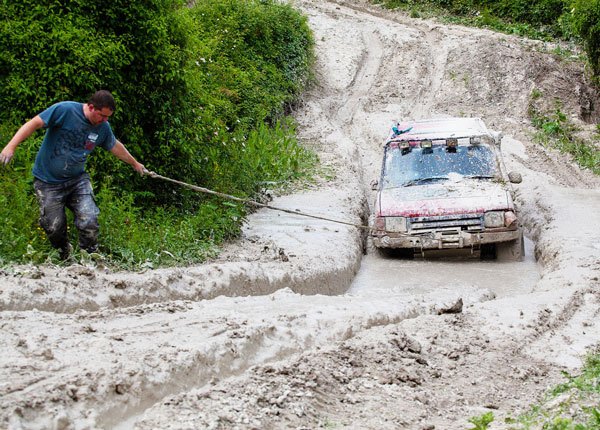
Driving in Hot Weather: Safety Tips, Vehicle Checks, Handling Emergencies
Updated Nov. 16, 2020Driving in extremely hot weather can be harmful to your health, and the health of your vehicle. According to the National Oceanic and Atmospheric Administration (NOAA) website, heat is the number one weather-related killer in the United States.
Very few driving experiences are worse than being stuck by the road side in a heat-disabled vehicle waiting for help, as the temperature gauge hits triple-digit territory. Though if your vehicle breaks down suddenly on a busy highway, you are lucky to make it to the side of the road at all.
By understanding the risks posed by high temperatures, you can prepare your vehicle for safe travel in hot weather and make sure you have done everything necessary to protect your health.
When traveling in very hot weather, always keep an eye on the temperature warning light. If it goes on, or if the gauge enters the red zone, pull your vehicle over to the side of the road and stop. Keep well away from traffic and park in the shade, if any is available.
Safety tips
When traveling in extreme heat, you and your passengers can become dehydrated quickly. The symptoms of dehydration include headache, tiredness and dizziness – not good when you’re in control of a vehicle! Stay cool, hydrated and safe using the hot weather safety tips below:
- Follow the vehicle check tips below to make sure your car is fit for the journey
- Avoid busy highways and roads where you may get stuck in standing traffic
- Pack plenty of water, in a cooler if possible
- Include snacks, as hunger can worsen heat stroke
- Use the air-con or wind down the windows to keep the car cool
- Keep sunscreen and sun hats on hand, just in case your car breaks down and you must wait for rescue in the sun
If your car overheats or breaks down:
- Activate hazard lights
- Pull over to the side of the road if possible, remaining in the vehicle with doors and windows open if no other shade is available. Keep an eye on the temperature in the vehicle
- If your car breaks down on the road and cannot be moved, exit the vehicle and try to find shade at the side of the road while you wait for assistance
- If your car may be experiencing vapor lock, you can attempt to cool the engine with water.
- Never open the radiator cap until the engine has totally cooled, as boiling steam and liquid could be released
- Call 911 if you are stranded and in a remote area and unable to re-start your vehicle
Hot weather vehicle checks
Always take a moment to check over the most vulnerable parts of your vehicle before driving in hot weather. A little extra time spent prior to your journey could save you a lot of hassle and a potentially life-threatening situation later. Use the guidance listed here to make sure your car is hot weather ready.
- 1

Battery.
Check and service your car battery. Hot weather can be just as bad for your battery as extremely cold weather. If you have a maintenance-free battery, check it over thoroughly for cracks and leaks. All batteries should have corrosion cleared from the terminals and connections checked. - 2

Tires.
Make sure your tires are properly inflated. Under-inflated tires are a danger in hot weather, as they are subject to greater friction than fully-inflated tires. Of course, friction means even more heat. If your tires get too hot, they could blow out or even catch fire. Over-inflated tires can be equally problematic, as the air inside them may expand in hot weather and cause them to burst. - 3

Cooling system.
This requires special attention as extremely hot weather will put the system under strain. Check over your radiator, making sure the coolant is regularly replaced and topped up if the level is running low. - 4

Check your fluids.
Motor oil, transmission fluid, brake fluid, power-steering fluid and windshield wiper fluid may all be at risk of running dry in hot weather. Keep them topped up and double-check each one before any long journey. - 5

Belts, hoses and connections.
These can be weakened in extremely hot weather. Unless you are an expert, it is best to get these components checked by a mechanic.
Vapor lock
Vapor lock can be a problem in older, carbureted cars. This dangerous engine malfunction can happen in extremely hot weather, if the temperature in the engine and fuel lines gets high enough to vaporize gas. When gas is vaporized before it can reach the engine, the car may sputter or lose power altogether and die.
When vapor lock strikes, your only option is to allow the fuel lines and engine to cool before attempting to restart the vehicle. Pull over to the side of the road as soon as you suspect vapor lock. With the ignition off, you can pour cold water over the fuel tank, carburetor and fuel lines to condense the vaporized fuel. Be aware that there is an even greater risk of vapor lock when stopping and starting your vehicle in slow-moving traffic.
Heat-warped roads
Extremely hot weather can cause the road’s surface to warp or buckle. Sometimes referred to as a “blow-up”, this occurs when small cracks in the pavement allow moisture to seep in, which then expands in the heat. This is more often a problem on secondary roads than it is on busy highways.
Reduce your speed and keep an eye out for buckled pavements, as they could cause you to lose control of your vehicle.
Children in hot cars
Did you know that the temperature inside a stationary car can rise 20 degrees in just ten minutes on a hot day? Children, senior citizens, people with chronic illnesses and animals are all extremely vulnerable to dehydration and heatstroke. Though even people who do not fit these categories are susceptible to getting sick when exposed to high temperatures for an extended time.
According to National Safety Council statistics, 48 children died from being left in hot cars from January through to September 2018. Every one of these deaths was preventable, caused by children gaining access to unattended cars, or being left in the backseat by distracted parents and caregivers.
These tips are taken from the Safe Kids Worldwide tip-sheet for heat-stroke prevention:
- Never leave a child alone in a car, not even for one minute
- Always keep cars locked when not in use, so children cannot gain access
- Place something essential on the backseat – such as a purse or shoe – to make sure you do not forget a sleeping child
- Call 911 if you see a child alone in a car




